Chronicle of the German Museum of Books and Writing
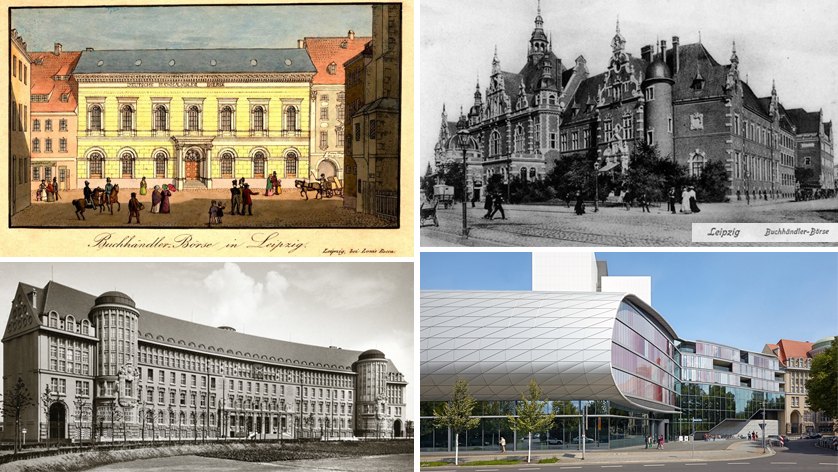 Photos: DNB; Image 4 PUNCTUM / Alexander Schmidt
Photos: DNB; Image 4 PUNCTUM / Alexander Schmidt
2011 until today
2021
Acquisition of Armin Abmeier’s collection of comics
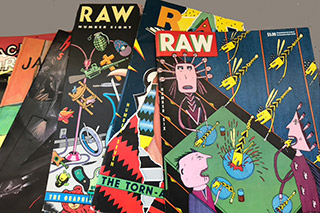 Photo: Rotraut Susanne Berner, copyright protected
Photo: Rotraut Susanne Berner, copyright protected
With the acquisition of the Armin Abmeier collection, the museum has added an extensive collection of American underground and independent comics to its holdings. The collection, which was assembled over several decades, includes not only underground and independent comics but also graphzines, artists’ publications, illustrated books, serial publications, secondary literature and various other items such as postcards, records, CDs and videos issued between the early 1960s and 2012.
2019
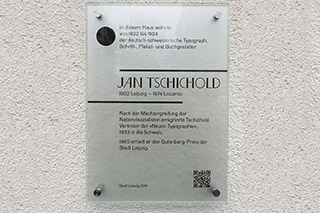 Photo: DNB, Claudia Seeber
Photo: DNB, Claudia Seeber
The Museum’s exhibition “Jan Tschichold – a once-in-a-century typographer?” is dedicated to one of the most well-known typographers. The City of Leipzig has installed a memorial plaque in Tschichold’s honour at Schorlemmer Straße 8 – one of the houses he lived in during the 1920s.
2017
Acquisition of 60 photographs from the “Bookish!” collection
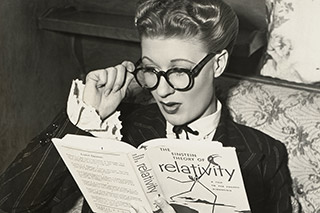 Image: DNB
Image: DNB
The German National Library acquires 60 photographs from the “Bookish!” collection, brought together by Günter Karl Bose, for the graphic collection of the German Museum of Books and Writing in 2017. Selected images were already available to view in 2016 at the exhibition “Reading a Book? Hollywood Reads” held in the display vault of the German Museum of Books and Writing. The photographs show Joan Crawford, Clark Gable, Marilyn Monroe and Ronald Reagan as they read books – a kind of promotional image for every 20th-century Hollywood star: does the “prop” of a book serve as evidence of education, one might ask?
2016
Brief guide to the permanent exhibition “Signs – Books – Networks: from Cuneiform Script to Binary Code”
The brief guide through the permanent exhibition of the German Museum of Books and Writing at the German National Gallery becomes available on 14 March 2016. Under the title “Signs – Books – Networks: from Cuneiform Script to Binary Code”, the book on the exhibition of the same name in Leipzig provides a brief history of humankind’s use of media. Richly illustrated and written in a succinct style, the brief guide follows the milestones in media innovation: the invention of writing 5,000 years ago, book printing with movable letters in the 15th century, and digital net worlds.
Noteworthy acquisitions: the pre-mortem legacy of graphic artist Gert Wunderlich
The German Museum of Books and Writing receives the pre-mortem legacy of graphic artist Gert Wunderlich. He is one of the key typographers and font and book designers in the German-speaking world. His commercial graphic work includes numerous poster designs – such as the “Fukushima” poster created in 2011, which translates the nuclear disaster on the Japanese coast into an impressive visual language.
2015
Welcome – help for refugees at the German National Library in Leipzig
From the summer of 2015 onwards, the German National Library helps refugees at the point where the library’s specific range of tasks and the skills and experience of its employees can be put to good use.The work therefore focuses on three topic areas in particular, which the German National Library establishes as long-term offerings in line with the recommendations of the Leipzig Refugee Council, which received an award for its services to integration from the German state: at the “Hands-On Museum”, refugee children are invited and instructed to experiment with paper, writing and printing; academic refugees receive temporary user cards from the German National Library free of charge, as well as assistance in contacting German research institutes in collaboration with the “Chance for Science” network. Furthermore, colleagues support children and adults in learning German and communicating in everyday situations, something which is offered in collaboration with schools as part of so-called DaZ classes (“Deutsch als Zweitsprache”, “German as a second language”), in thematically organised small groups held in the exhibition rooms of the German Museum of Books and Writing, or as part of language teaching from professional providers in the rooms of the German National Library.
Noteworthy antiquarian acquisitions: photographs by Gerhard Hopf
The collection of images relevant to media history held at the German Museum of Books and Writing is enriched with a selection of 70 black-and-white photographs by Gerhard Hopf (*1946) taken between 1967 and 1991. The famous Leipzig-based photojournalist, who also worked on behalf of the Leipzig and Frankfurt Börsenblatt, found his motifs in “the GDR as a country of readers”, and documented literary figures and critics at book festivals and fairs, in schools, libraries and book shops. With his 1990 “Reports from the Interim Period”, he created an oppressive documentary of the once-splendid architecture in the Graphic Quarter of Leipzig, the city of books and publishing.
2014
Virtual exhibition “5,000 Years of Media History”
In time to mark International Museum Day, the German Museum of Books and Writing goes online on 18 May with its virtual exhibition “5,000 Years of Media History”. The exhibition provides succinctly told stories, images, films and audio commentary on the 11 thematic modules of the permanent exhibition “Signs – Books – Networks: from Cuneiform Script to Binary Code”.
2013
Antiquaria Award for permanent exhibition
On 24 January 2013, the permanent exhibition “Signs – Books – Networks: from Cuneiform Script to Binary Code” is honoured with the ANTIQUARIA Award, which is presented annually by the “Buchkultur e. V.” (“Book Culture”) association for special services to promoting and maintaining book culture.
2012
Display vault for showcase exhibitions
The re-opening of the German Museum of Books and Writing on 13 March also marks the inauguration of the display vault. This becomes the venue for three small showcase exhibitions every year.
Opening of the permanent exhibition “Signs – Books – Networks: from Cuneiform Script to Binary Code”
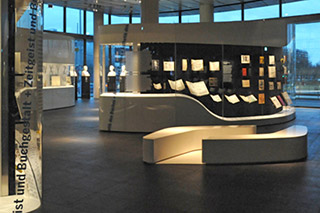 Photo: DNB, Norbert Bensch
Photo: DNB, Norbert Bensch
13 March sees the formal opening of the newly designed permanent exhibition “Signs – Books – Networks: from Cuneiform Script to Binary Code” as a showcase for the German National Library. It provides insight into humankind’s three great media innovations, from the invention of writing, to book printing, through to the digital net world.
2011
Opening of the modern museum reading room
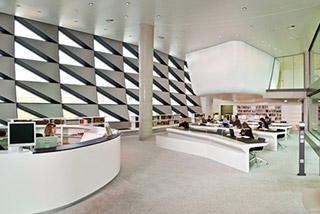 Photo: DNB
Photo: DNB
A new, modern museum reading room with open-access shelving for around 3,500 German- and foreign-language books and journals on book culture and media history opens in March. This is where the comprehensive specialist library and collection holdings of the museum can be used by researchers, students and practitioners.
Museum gallery opens
The museum gallery in the extension building of the German National Library opens in February. Under the motto “Hands-On Museum”, the younger generation in particular here has the opportunity to playfully explore book and media history.
1985–2010
2010
Acquisition: exhibits on Korean printing technology
In December, the museum receives a generous donation on Korean printing techniques from the Early Printing Museum Cheongju. Around 450 exhibits – from various raw materials, to stencils, moulds and type cases, through to finished metal letters – faithfully reproduce and document the individual processes of Korean letterpress printing, which was practised to print books using movable letters 80 years prior to Gutenberg’s invention.
Move to the modern library building begins
In June, the relocation of the books and staff to the fourth expansion of the German National Library gets under way. Here the museum receives new exhibition spaces, an attractive reading room, expanded stacks and museum infrastructure. The opening of the gallery for visitor promotions and museum teaching, the new museum reading room and a display vault for special presentation follows in early 2011. The newly designed permanent exhibition, which tells a little of human history from the invention of writing, to book printing with movable letters, through to the digital net world, opens in early 2012.
2009
125th anniversary of the German Museum of Books and Writing
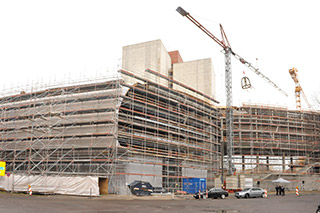 Photo: DNB, Norbert Bensch
Photo: DNB, Norbert Bensch
On 24 September 2009, the 125th anniversary of the museum is celebrated at the German National Library in Leipzig during a commemorative event with around 300 guests. One of the event’s highlights is the discussion between the journalist Thomas Bille and Michael Faber, Professor Johannes Ulrich Schneider and Professor Wolfgang Ernst on the expectations of the German Museum of Books and Writing and its future permanent exhibition.
Internet portal “memoryofpaper” online
Following its 30-month-long involvement in the eContenPlus Project Bernstein, the museum makes over 31,000 titles on paper history and watermarks available as specialist information online via the portal www.memoryofpaper.eu.
Acquisition: the partial legacy of Hans-Joachim Walch
The museum prepares to receive a large part of the artistic legacy of Leipzig-based typographer and illustrator Hans-Joachim Walch (1927–1991) as a donation.
2008
Digitisation and cataloguing of the portrait collection
In a project initially funded by the DFG, 3,500 printed portraits of book printers, book dealers and publishers from the 16th century to the 20th century held in the library of the German Book Traders’ Association of Leipzig are catalogued and digitised. These sources, which are unique in their thematic coherence, are available online as an interdisciplinary information resource via the Internet portal of the Art and Architecture Image Index.
Acquisition: Mark Lehmstedt collection
The museum purchases a collection from the Leipzig publisher Dr. Mark Lehmstedt, which contains 275 autographs and documents on the history of the book trade from the 18th to the 20 century. These include letters from and to the major Leipzig publishers Georg Joachim Göschen and Philipp Erasmus Reich.
Closing event for the permanent exhibition “Mercury and Books”
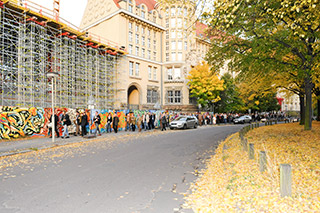 Photo: DNB
Photo: DNB
Owing to refurbishment work and conceptual preparations for a new permanent exhibition, the permanent exhibition “Mercury and Books” closes on 8 October 2008 with an event dedicated to the motto “Departure”. The review of twelve years of welcoming and educating visitors on the topic of “Leipzig as the Home of Books” is combined with a look towards the future.
2007
Acquisition: the partial legacy of Hans Ticha
The museum purchases a major portion of the book-design work by painter, graphic artist and book designer Hans Ticha (born 1940) with the support of Gesellschaft für das Buch. The purchase is accompanied by materials donated by the artist.
Acquisition: donation by Paul Zimmermann
The Leipzig-based painter and book and font designer Paul Zimmermann (born 1920) donates a bundle of 180 font-design works to the museum.
New leadership:
Dr Stephanie Jacobs (born 1963) becomes the Director of the museum.
2006
The new “Law Regarding the German National Library” comes into force
The German Museum of Books and Writing is included as a task of the German National Library for the first time in the wording in the Law Regarding the German National Library of 22 June 2006.
Acquisition: the partial legacy of Jan Tschichold
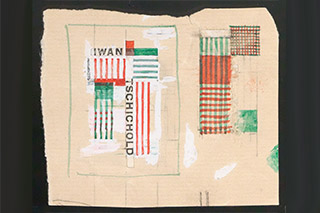 Lilo Tschichold
Lilo Tschichold
An extensive partial legacy of the major typographer, calligrapher and commercial graphic artist Jan Tschichold (1902–1974) is handed to the museum as a deposit by his daughter-in-law Lilo Tschichold.
2005
Acquisition: German Book Traders’ Association
The German Book Traders’ Association hands over the archive materials, business circulars, publisher catalogues and loose-leaf collections – including 3,300 book-trader portraits – from the library of the German Book Traders’ Association of Leipzig.
Special exhibition “Giving and Taking”
With its special exhibition “Giving and Taking”, the museum honours private and institutional patrons who have sustainably supported its collection expansion work and cataloguing activities with foundations and donations ever since the museum was founded.
2004
Acquisition: the legacy of Peter Willberg
The museum receives the legacy of typographer, book designer, lecturer and specialist author Professor Hans Peter Willberg as a donation from his life partner and colleague Brigitte Willberg.
2003
Publication: International Bibliography of Paper History
Following 15 years of preliminary work, the International Bibliography of Paper History (Internationale Bibliographie zur Papiergeschichte, IBP), whose four volumes provide access to 20,000 title records, is published in 2003.
2001
Acquisition: the pre-mortem legacy of Axel Bertram
Between 2001 and 2003, the museum purchases the artistic work of graphic designer Professor Axel Bertram (born 1936). The extensive pre-mortem legacy is inventoried with the support of the Birkner Foundation and catalogued in a database. Works created after this time continue to be added to the collection.
2000
Acquisition: B. G. Teubner publisher’s archive
In March, the publishing company B. G. Teubner Stuttgart und Leipzig donates its publisher’s archive to the museum. The Leipzig donation is complemented by the written material handed to the Saxon State Archive in Leipzig prior to 1990.
Exhibition series “Gutenberg 2000”
The 600th birthday of Johannes Gutenberg serves as the occasion to host a trilogy of exhibitions until March 2002 under the guiding theme “Gutenberg 2000”. Using historical and artistic perspectives, the exhibitions address questions concerning the so-called “end of the age of books” and the transition to a new media world.
1999
Special exhibition “100 Years of Insel Verlag”
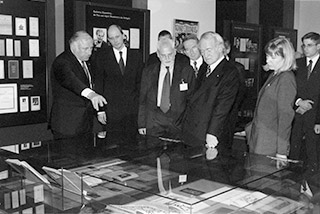 Image: DNB
Image: DNB
As part of a formal event attended by German President Johannes Rau, the special exhibition “100 Years of Insel Verlag” is opened in the completely redesigned special exhibition room on 10 November 1999.
Acquisition: historic writing and drawing implements
A collection of writing and drawing implements from the 19th and 20th century (around 470 individual objects) is gifted to the museum in lots by Margit and Hans-Günter Kowalski from 1999 onwards.
1998
Exhibition and symposium in Kyoto
The Japan Paper Academy (Kyoto) exhibits over 400 objects from the Bartsch Collection in Imadate, Kyoto, Mino, Tokyo and Ino (until 1999) and marks the occasion by publishing a richly illustrated catalogue.
1997
Acquisition: the partial legacy of Albert Kapr
The museum acquires a partial legacy from the book and font designer, lecturer and specialist author Professor Albert Kapr (1918–1995). This collection is inventoried and catalogued with the support of the Birkner Foundation and with public funding.
Cataloguing: circulars of the book trade
The cataloguing of the approximately 25,000 circulars of the book trade (approx. 65,000 copies) from the library of the German Book Traders’ Association of Leipzig begins with the initial support of the Volkswagen Foundation. The cataloguing data of these unique sources on the book trade for the period from 1737 to the mid-20th century are accessible online. Dr Gerhard Mühlinghaus leaves to the museum a set of publishers’ bindings from the 19th and 20th century already contained in his private collection.
The Goethe Institute in Kyoto hosts a symposium focusing on the Bartsch Collection.
1996
Opening of the permanent exhibition “Mercury and Books. 500 Years of Leipzig as the Home of Books”
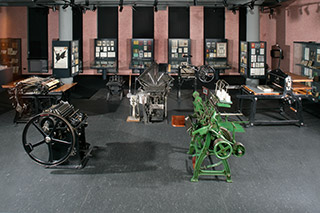 Photo: Christoph Sandig, copyright protected
Photo: Christoph Sandig, copyright protected
Following a major refurbishment and redesign of the exhibition rooms with modern exhibition technology, the new permanent exhibition “Mercury and Books. 500 years of Leipzig as the Home of Books” opens on 14 May 1996. It presents Leipzig’s journey from the beginnings of long-distance trading with books and the printing of the first book in 1481, through to the year 1995 – a time in which the effects of the privatisation and retransfer of publicly operated publishing companies and the search for economically viable approaches in the printing industry, the publishing trade and the book trade become apparent, and an era in which one must question how justified Leipzig’s reputation as a city of books really is.
Exhibition and congress of the international paper historians
The International Association of Paper Historians (IPH) holds its 23rd congress, titled “Paper History as a Helpful Science”, at the Deutsche Bücherei Leipzig. To mark the occasion, the museum hosts the special exhibition “Traditions of Paper History Research”.
1995
The Museum of Books as a national documentation centre
The Academic Council calls for the further development of the museum in order to create a national documentation centre for German-language book culture as an integral part of the Deutsche Bibliothek.
Acquisition: an autograph collection of Herbert G. Göpfert
The museum acquires a large part of the autograph collection belonging to the literary and book scholar Professor Herbert G. Göpfert (1907–2007). The collection contains over 450 letters and documents from the 18th to the 20th century, including ones written by Georg Joachim Göschen, Friedrich Perthes and Theodor Fontane.
1994
Memorandum on the German Museum of Books and Writing
An expert committee convened by the administrative council presents a memorandum on the further development of the museum, based on the current situation of books in a changing media world and providing an international comparison. The role favoured by the committee is described as that of a documentation centre dedicated to preserving book culture.
Acquisition: dandy rolls and sample room
Felix Schoeller jr.Foto- und Spezialpapiere GmbH & Co KG, Osnabrück, which since 1990 has owned Freiberger Papierfabrik zu Weißenborn GmbH, donates to the museum from the collection of this paper factory over 200 dandy rolls once used to produce watermarked papers, as well as the paper factory’s sample room, whose pattern samples document the paper factory’s entire production during the period from 1950 to 1990.
1993
In October, a German working group conducting research at the Russian State Library determines that the most precious holdings of the Saxon Bibliographic Collection, which since 1945 had been classified as destroyed during the war, are in fact virtually complete, in a great state of preservation and comprehensively compiled. These holdings encompass rare, very rare and unique items, including the parchment copy of the Gutenberg bible, which piques the particular interest of both experts and the public. The collection of Becher bindings taken from the same storage site in 1945 is also kept at the Moscow Library. The existence of a collection of Forrer fabric prints is only revealed in October 1998. The incunabula held in Moscow have been recorded online since 2000 in an index of the museum’s early print publications.
The administrative council of the Deutsche Bibliothek emphasises that, under its traditional name “German Museum of Books and Writing” (“Deutsches Buch- und Schriftmuseum”), the museum should in future function as a documentation centre for German book culture primarily serving the needs of researchers.
On 15 March 1993, the Book Art Foundation undertakes to donate to the museum its exhibits from its past and future exhibitions “Most Beautiful Books of the World” and “Original Book Art” for the purposes of education and supporting the world of academia. The museum oversees the incorporation and cataloguing of the exhibits and makes the books available for use.
Owing to contractual arrangements with their heirs, the legacies of the paper historian Dr Karl Theodor Weiß and his son Dr Wisso Weiß are transferred to the museum as a deposit.
1992
Between 1992 and 1997, the museum takes part in a DFG-funded project for recording archival sources on the book-trade and publishing history of the 19th and 20th century in Germany. The online database contains information from the search tools of the Federal Archive, from 55 state archives, 297 municipal archives and 217 church archives. The information relating to approximately 80,000 fascicles can be researched via a series of registers according to person, corporate body, provenance, etc.
Following a vote by the advisory committee of the Deutsche Bibliothek, the museum’s task is determined to be that of supporting researchers without primarily developing its own research activities.
The watermark collection of the former Research Centre for Paper History Mainz handed over by the German Museum is incorporated into the Paper History Collection.
With funding provided by the board of trustees of the association Haus des Buches e. V. (“House of Books”) in Leipzig, the museum is able to purchase a section of the reference library belonging to the Amsterdam-based antiquarian Abraham Horodisch (1898–1987). The purchase of the approximately 1,400 titles allows the museum to close gaps in its foreign-language specialist literature in particular.
For the symbolic sum of 1 DM paid to the Treuhandanstalt, the museum purchases 14 printing machines from the Polygraph combine’s collection of historic machines. Over the following years, the museum also purchases individual machines from private sellers in order to have examples of so-called prototypes of industrial book production in its collection. The restoration of the machines gets under way in 1993.
1991
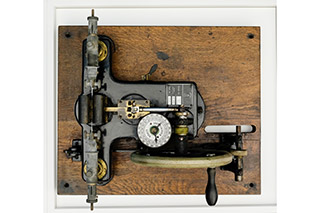 Photo: DNB, Stephan Jockel
Photo: DNB, Stephan Jockel
During the reorganisation of the museum’s areas of work, the so-called Exhibition Collection is repositioned as the Cultural History Collection. Historical texts, early books, tools and machines for producing books, texts and paper, book sculptures, paper art, etc. all form part of this collection.
The first annual edition of the Leipzig Year Book on Book History is published in a collaboration between Die Deutsche Bibliothek and the Leipzig Working Group for the History of Books, which was founded in 1990 and maintains close ties to the museum. In the following years, the museum is also involved in the academic conferences of the Leipzig Working Group.
1990
In planning the merger of the Deutsche Bücherei in Leipzig and the Deutsche Bibliothek in Frankfurt am Main following German Reunification, it is emphasised that the Leipzig site should serve as a research centre for books and book-trade history within the unified National Library.
To mark the 600th anniversary of paper production in Germany, the symposium “On the State of Paper-History Research in Germany” is held in Berlin with the involvement of paper historians and researchers from East and West Germany.
The occasion is used to found the German Working Group for Paper History (Deutscher Arbeitskreis für Papiergeschichte, DAP), an association which to this day hosts conferences at the museum and forges working contacts among interested parties.
In 1990 and 1991, the Fritz Thyssen Foundation provides funds for the acquisition of computing technology and the purchase of specialist literature for the fields of book studies, printing, book design, writing materials and bibliographic reference works. Acquired as antiquarian copies or new publications, the titles complete the specialist library with literature that wasn’t available prior to 1990 and with foreign-language texts.
1989
The complete, historically unique book-trade archive owned by the library of the German Book Traders’ Association of Leipzig is merged with the newly acquired archival material to form a new collection unit, “Archival Materials and Documents Relating to Book History”. The collection today encompasses 170,000 textual and image sources from the 16th to the 21st century.
The museum is involved in a communal exhibition by Leipzig’s museums, titled “Mercury and the Muses. Treasures of World Heritage from Leipzig” and held at the Künstlerhaus in Vienna from 21 September 1989 to 18 February 1990.
1988
An exhibition titled “Books as a Museum Exhibit. From Gutenberg to the Present” is held at the GDR Centre for Culture in Paris from 26 October to 30 November 1988.
Between 1988 and 1990, the museum acquires approximately 1,000 19th-century loose-leaf publications of popular and mercantile graphics (book illustrations, illustrated sheets, devotional pictures, company and product labels, business cards, etc.) from the Leipzig-based artist and collector Heiner Vogel (born 1925).
1987
The museum begins to collect a selection of artists’ books and literary journals published outside the official book and art trade. A complete bibliography of these publications is commissioned. Edited by Jens Henkel and Sabine Russ, it is published in 1990 under the title “Self-Published Artists’ Books and Original Graphic Journals ”.
1985
Following the move of the Deutsche Bücherei’s restoration workshop, which is allocated to the museum, to new premises with modern equipment, it is hived off from the museum’s structure in 1987. The workshop increases its efforts to intensify mass restoration and further mechanise its processes. Today’s centre for preserving the museum’s collection is established in 1998. Lothar Poethe (born 1947) becomes the director of the museum.
1944–1984
1984
The 100th anniversary of the museum is commemorated with a formal ceremony. To mark the anniversary, an international symposium on the topic “Books as a Museum Object” is held. “Treasures of the German Museum of Books and Writing” are displayed in a special exhibition. The Klemm Collection is enriched with a new collection group, “Modern Artists’ Books”.
1981
To mark the 47th conference of the General Assembly of the IFLA in Leipzig, a new permanent exhibition titled “Books and Society” is presented to the public in August 1981. In order to utilise the exhibition for intensive teaching work, the development of book culture is presented as part of social development processes as a whole while taking account of various aspects of museum education work. The museum acquires the paper-history legacy of Zwickau-based state archivist Karl Steinmüller (1901–1977), primarily comprised of a watermark collection and 53 paper-packaging prints.
1970
Taking account of other existing paper collections, the subject area constituted by the German Paper Museum is renamed as the Paper History Collections.
The German Museum of Books and Writing receives the Gutenberg Prize from the city of Leipzig.
1965
The museum receives new work rooms, stacks and exhibition spaces in the newly constructed north-west wing of the Deutsche Bücherei. On 18 February 1965, the permanent exhibition “Books and Writing from the Early Modern Period to the Present” opens in an exhibition space measuring approximately 350 square metres. Designed as an educational exhibition on cultural history, it provides a systematic overview of the history of writing, book formats, book illustration, printing techniques and book design.
1964
The German Paper Museum, founded in Greiz in 1957 on the basis of the bequeathed private collections of Dr. Karl Theodor Weiß (1872–1945) and managed by his son Dr. Wisso Weiß (1904–1991), is incorporated as a subject area into the German Museum of Books and Writing.
1959
The museum is involved in the preparations for the International Book Art Exhibition in Leipzig, which is intended to serve as the continuation of the great book art exhibition of 1927. The museum is also actively involved in the planning and implementation of the five exhibitions that follow (1965, 1971, 1977, 1982 and 1989) by providing loan copies and its own contributions as well as performing groundwork. The museum receives the exhibits from the state and special exhibitions that are left behind in Leipzig.
On 1 January 1959, Leipzig City Council becomes the custodian of the historical collection of machines from the old stock of the German Book Industry Association that have been preserved and are not required for museum work. This collection is to be used in the city’s museums.
The German Book Traders’ Association of Leipzig transfers its equally war-damaged library to the Deutsche Bücherei for use in its museum. This results in the merger of the remaining collections of two comparable specialist libraries, whose unification had already been suggested by Carl B. Lorck in 1886.
1955
German cultural artefacts taken to Soviet territory by the occupying Soviet army during the war begins to be returned to the GDR by the Soviet Union, something which raises the hope that the treasures of the Book Museum – which had also been carted off in 1945 – might be returned. This hope proves to be in vain. The campaign of returns is declared completed by both governments in 1960 without a single book finding its way back to Leipzig. The Soviet Union does not even provide any confirmation that the collections still exist. The Central Committee of the Socialist Unity Party of Germany declares the matter closed and in 1961 imposes a ban on any mention of losses incurred as a result of the war.
The Artistic Prints Department is incorporated into the museum as a collection. This not only serves as compensation for the museum’s losses as a result of the war and closes the gaps in the series on the historic development of books up to the present day, but also re-establishes the connection between contemporary book design and the practice of book production, as well as the connection with educational institutions such as the Academy of Fine Arts in Leipzig, connections that had grown weaker since the 1920s.
Following the transfer of ownership of the Saxon Bibliographic Collection from the dissolved federal state of Saxony to the State Secretariat (later restructured into the Ministry for Universities and Schools), the collection’s holdings are merged with the old holdings of the dissolved German Book Industry Association to form a single collection, named the Klemm Collection in memory of Heinrich Klemm.
Dr. Fritz Funke (born 1920) becomes the director of the museum.
1954
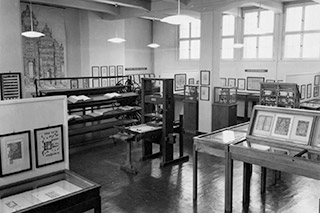 Image: DNB
Image: DNB
A new permanent exhibition opens on 4 May 1954. Across 25 groups, it presents the history of books and writing from the Near Eastern cuneiform-script cultures through to the present, thereby adhering to the original conception of cultural history while making this more comprehensible to the public. For examples of 20th-century books, the exhibition draws on the collections held in the Deutsche Bücherei’s Department of Artistic Prints.
1952
Book bindings and book covers are integrated into the Saxon Bibliographic Collection as a new collection group.
1950
The museum is transferred to the Deutsche Bücherei and incorporated into the library as a department. The re-establishment of the museum’s collections can now be continued in systematic fashion using regularly available internal funding.
1949
Following the city of Leipzig's unsuccessful attempt – made with the help of the German Book Industry Association – to re-establish the machine trade fairs of the pre-war era and forge economic contacts in the Western zones, the association is dissolved and its property transferred to the city of Leipzig.
1946
Those of the museum’s collections that remain intact – approximately 4,300 volumes from the Saxon Bibliographic Collection, 3,500 volumes of the specialist and sample library of the Book Industry Association, the Bartsch-Seegers Collection and other collection remnants – begin to be transferred to the Deutsche Bücherei in August.
The museum is provided with premises free of charge for an initial 10-year period; it also receives assurances that it can, in time, set up a permanent exhibition on the history of writing and books.
On 1 August 1946, Dr Hans H. Bockwitz is taken on by the Deutsche Bücherei as an employee. As no elected member of the Book Industry Association’s steering committee can be found and the association is therefore rendered incapable of action, a new steering committee is legally appointed in September.
1945
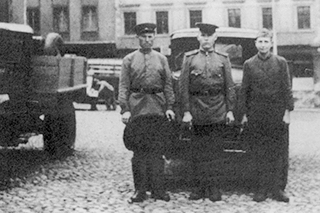 Image/Repro: DNB
Image/Repro: DNB
On 22 September 1945, one of the so-called trophy committees of the occupying Soviet forces commandeers the manuscripts, books, book bindings and fabric prints that have been relocated to Castle Rauenstein. The larger share of these is transported to the Lenin Library (what is today the Russian State Library) via Berlin by plane in October, with the smaller share following by train in February 1946. Attempts to establish where the museum’s possessions are located and secure their return remain unsuccessful.
Dr Raymund Schmidt, co-owner of the company Oscar Brandstetter, founds a bookplate collection with around 3,500 sheets.
1944
The re-establishment of the museum’s collections gets under way; a new inventory for the collections is begun on 20 August 1944. The museum receives numerous donations from companies and private individuals. Additional books and journals are acquired on the antiquarian market. In November 1944, 53 sheets containing miniature copies are purchased from Schoppmeyer.
At the close of 1944, the most precious collections are relocated to Castle Rauhenstein in Lengenfeld, situated in the Ore Mountains, with the assistance of the Deutsche Bücherei. This is also where the major portion of the Deutsche Bücherei’s collections are stored.
1915–1943
1943
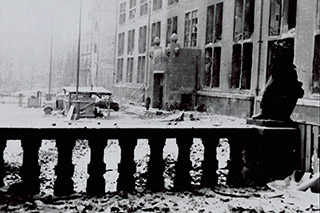 Image: DNB
Image: DNB
During the British aerial bombardment of 4 Decembre 1943, the Buchgewerbehaus (“House of the Book Trade”) is badly damaged by explosive and incendiary bombs. Collections in the exhibitions and stacks are lost. Although the Saxon Bibliographic Collection, which is stored in the cellars, is preserved in its entirety; around 90 per cent of the specialist and sample library is lost, with 60,000 of 62,000 volumes going up in flames. The Schoppmeyer collection and the Weißenbach loose-leaf collection are among those destroyed.
1940
On St. John’s Day, the museum opens a new showcase collection in the extension of the Deutsches Buchgewerbehaus as part of the secular Gutenberg celebrations in Leipzig, whose scope is greatly reduced on account of the war. The exhibition spans 24 rooms and once more provides an overview of the development of books and writing grounded in cultural and universal history.
In late 1940, following the outbreak of aerial warfare, the most precious manuscripts and incunabula from the Saxon Bibliographic Collection are packed up in crates and stored in the vaults of a bank, followed in mid-1942 by the Becher and Forrer collections.
1939
The museum begins its move into an extension of the Deutsches Buchgewerbehaus at Gutenbergplatz erected between 1936 and 1938. The top floor and attic floor contain around 800 m² of work rooms and stacks, as well as an exhibition space of around 1,000 m².
1936
The reduction in student numbers at the Librarianship School following the hiring freeze at all libraries provides the final impetus to dissolve the German Association for the Study of Books and Writing. The German Book Industry Association once more assumes full legal responsibility for the museum and plans to house it in the extension of the Buchgewerbehaus, the construction of which has just got under way. The Museum thereby also once more becomes the custodian of the technical collection that has been in the possession of the Book Industry Association since 1917.
In a memorandum, the director of the Deutsche Bücherei, Dr Heinrich Uhlendahl (1886–1954), and the lord mayor of Leipzig, Dr Carl Goerdeler (1884–1945), present their “Consideration on the Construction Site for the German Book Museum” and make their case for not relocating the museum in the Buchgewerbehaus, but instead housing it in an extension of the library in close collaboration between both institutions.
1935
The museum’s sponsoring association is forced to change its name to “German Association for the Study of Books and Writing”, apparently in order to avoid any confusion with the Reich Chamber of Literature, which was founded to implement National Socialist literary policy.
1934
With the key involvement of NSDAP members, the Book Industry Association is reorganised and the so-called conformity thereby completed. Owing to the close links with the museum’s sponsoring association, the latter is thereby essentially disempowered. Unlike his predecessors, the museum’s director, Dr Hans H. Bockwitz, is not appointed as a member of the Saxon Examination Office.
1929
Dr Hans H. Bockwitz (1884–1954), who has already been involved with the museum since 1915 – first as a volunteer, later as an assistant to the director – takes over the directorship.
1928
Owing to the failure to meet various stipulations of the Saxon authorities in a timely fashion, if at all, the state of Saxony considers re-appropriating the Saxon Bibliographic Collection. This is prevented at the last minute.
1927
The yearbook “Books and Writing” edited by the museum’s librarian / director is published from 1927 to 1943.
1926
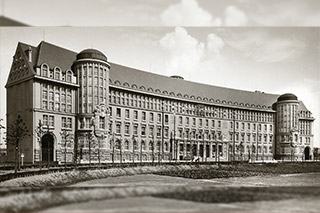 Image/Repro: DNB
Image/Repro: DNB
Just a few weeks after the 40th anniversary of the opening of the Book Industry Museum, it is forced to move site owing to pressing rent arrears and the refusal of further support from the state and the city of Leipzig; the museum moves to the Deutsche Bücherei in December 1925. The tenancy agreement for four rooms on the second floor and two stacks on the fifth floor begins on 1 January 1926. Only a few objects from the collection can be exhibited, some of them in the corridor, even though the museum is permitted to share the library’s exhibition space. In the years that follow, the museum barely has any sort of public presence.
1925
Following the withdrawing of capital and owing to losses incurred as a result of war and inflation, the fund for the continuation of the Saxon Bibliographic Collection is finally depleted.
1922
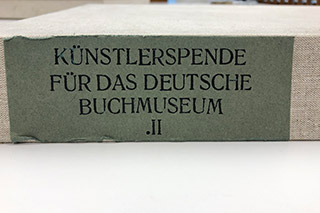 Photo: DNB
Photo: DNB
The sale of the Gutenberg bible from the Saxon Bibliographic Collection to secure the funds for the museum’s continued existence is prevented thanks to the sale of a folder of graphic works by Lovis Corinth, Paul Klee, Oskar Kokoschka, Käthe Kollwitz, Alfred Kubin and Max Slevogt, titled “Artists’ Donation for the German Book Museum.
1920
In the post-war crisis and the turbulences of inflation, the precarious situation of the sponsoring association becomes apparent. Its financial situation dramatically worsens. Many of the association’s members can no longer afford the membership fee. The museum staff are dependent on the cost-of-living bonuses that become necessary at ever shorter intervals, and in 1923 submit a petition highlighting the need for their wages to be increased.
1918
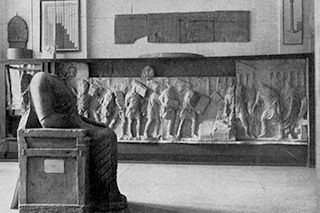 Image/Repro: DNB
Image/Repro: DNB
Renamed as the “Museum of German Culture” – a name reminiscent of Bugra, the International Exhibition of Books and Graphics – the museum reopens on 12 October 1918 in the premises of the Association of German Commercial Employees in Zeitzer Strasse (what is today Karl-Liebknecht-Strasse). The name is soon changed to “German Museum of Books and Writing”. Its permanent exhibition encompasses 44 rooms and represents a continuation of the exhibition in the Kuppelhalle, albeit in reduced scope.
A great number of academic essays on the history of books and writing is published in the journal of the German Association for Books and Literature up until 1924.
1917
The fundamental changes to the museum also spur on the restructuring of its organisation. The German Association for Books and Literature is founded as the new sponsoring association on 15 December 1917. Its primary task is to make the museum usable for academic purposes and continue the collections entrusted to it. Despite the devastating war situation, it is assumed that the extensive war bonds of numerous patrons will in future provide a solid economic footing for the work performed by the association.
1916
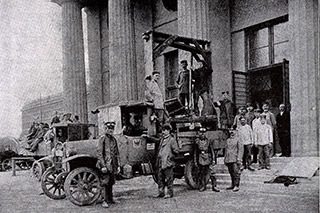 Image/Repro: DNB
Image/Repro: DNB
Following the clearance of the Kuppelhalle after it is commandeered by the military authorities, the museum’s collections have to be transferred to stacks. The specialist library and reading rooms are temporarily housed in the Buchhändlerhaus (“Book Dealers’ House”).
1915
On 1 May 1915, an expanded exhibition is presented by the museum at the Kuppelhalle on the exhibition grounds in Leipzig’s eastern district. It is the first time that the exhibition is structured according to a cultural history concept. It includes a Chinese university, a Japanese book shop, exhibits of Islamic and Indian culture, material on the history of writing, and writing materials from China and Japan, as well as an Oriental collection.
The German Book Industry Association founds a school for librarians and museum officials, overseen by the museum’s director. This institution prepares its students for mid-level service at the library and provides funds that are used for the museum’s work and remunerating staff.
1900–1914
1914
Dr Albert Schramm is appointed the academic director of the Bugra, which leads him to collaborate closely with Professor Karl Lamprecht (1856–1915), who takes over the management of the exhibition's Cultural History Department. The museum acquires an extensive number of exhibits, many of them from the Cultural History Department.
By adopting Professor Karl Lamprecht’s concept of presenting books and writing within a universal cultural-historical context, the scope of a (book-)trade museum is finally exceeded.
The hope of establishing a dedicated museum building with funds from Bugra revenue surpluses vanishes with the outbreak of war. The museum’s work is almost entirely abandoned as its staff members are conscripted for military duty. The museum is forced to draw on the capital of the “Fund for the Continuation of the Saxon Bibliographic Collection”, as the interest income is no longer sufficient to cover the necessary expenses, especially those involved in funding new acquisitions.
With donations provided by Krupp von Bohlen and Halbachs, as well as funds from the Wilhelm and Berta von Baensch Foundation, the museum acquires 334 loose-leaf sheets that Ansgar Schoppmeyer (1875–1922) created based on medieval miniatures for the purposes of study and teaching. Schoppmeyer had intensively engaged with medieval painting and calligraphy, and used these historical techniques to copy the templates from the major manuscripts held in European libraries. It takes until 1923 to pay all the instalments of the purchasing fee. The collection is lost in the war; however, 85 of Schoppmeyer’s other works are later acquired.
A collection of fabric prints is acquired from the private collection of Dr Robert Forrer (1866–1947). These examples of 14th-century fabrics printed with printing blocks are used within the museum’s work as a precursor to book printing. The collection was confiscated in 1945 and has been located in the Russian State Library in Moscow ever since.
1913
The museum’s range of tasks is considerably expanded when it takes over collection objects and specialist literature on the history of writing and stenography from the Dresden State Office for Stenography. The historical timeline now stretches back to the prehistoric era. With a focus on the Bugra and the later use of the museum, the institution raises funds specifically intended for the purchase of originals and the creation of replicas and casts.
The museum’s name is changed to the “German Book Trade and Writing Museum”.
The museum is able to acquire materials on the history of collotype printing from the estate of Joseph Albert (1825–1886) (Albert Heller Collection) to add to its collection of objects relating to the history of printing.
On 1 August 1913, Dr Albert Schramm (1880–1937) becomes the director of the German Book Trade and Writing Museum.
1911
By purchasing 406 historical book bindings from the Karlsbad-based collector Karl David Becher, the museum is above all able to acquire outstanding French and English works dating from the 17th and 18th century, as well as good illustrative examples of earlier style-epochs and from other countries. The collection, which was relocated in 1942, was confiscated in 1945 and has been in the possession of the Russian State Library in Moscow ever since.
From 1911 onwards, the museum’s work increasingly focuses on preparing for the International Book Trade and Graphics Exhibition (Bugra), planned to be held in Leipzig in 1914. The museum director is a member of the association specifically set up for this purpose and increasingly takes on coordinating tasks for every area of the exhibition.
1910
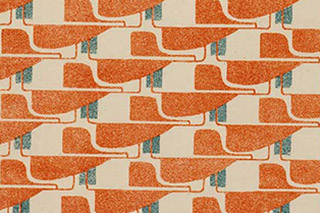 Image: DNB
Image: DNB
The Viennese privy councillor Franz Bartsch (1836–1910) gifts the German Book Industry Association his collection of papers, which spans approximately 10,000 pages and includes not only items of European origin (watermark papers, decorated papers) but also an extensive set of Chinese and especially Japanese papers. Although this collection survives the Second World War, the accompanying specialist literature is lost to the flames.
1909
Following failed purchase attempts in 1885 and 1897, in 1909 the museum succeeds in acquiring the book-trade collection of Professor Hans von Weißenbach (1847–1912) using donated funds. The museum’s loose-leaf collection is considerably enriched with the long-lost template collection for original graphic and reprographic techniques. During his employment at the Germanic Museum in Nuremberg from 1876 to 1879, Weißenbach had established a very extensive collection of individual sheets on typography, book illustration and design, as well as original and reprographic techniques from their initial invention to the present. He had already begun planning a museum based on this collection before 1884. This collection is also lost in the war.
1907
For the very first time, the museum receives funding from the Reich with which to carry out its work.
1903
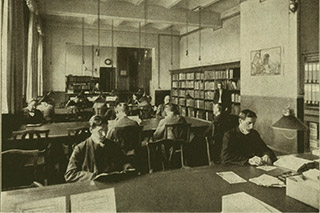 Image: DNB
Image: DNB
In September 1903, the museum director and association chairman take part in the Mannheim conference on “Museums as Places of Public Education”. The museum is already serving this cause by assisting employees of the book trade in their vocational training.
1902
The “cultural publisher” Eugen Diederichs (1867–1930) becomes a member of the museum’s commission.
1901
Ernst Seegers (1840–1911) sells his extensive collection of decorated paper, which contains around 11,500 patterns, to the German Book Industry Association. The collection provides a broad cross-section of predominantly German, French and Italian decorated paper production from the 17th to the 19th century, and encompasses all key techniques of hand production and industrial manufacturing. The Berlin-based commercial councillor Max Krause is able to raise over 4,000 marks from members of the Paper Industry Association and the Association of German Decorated Paper Manufacturers for the purchase.
The museum’s profile is raised considerably when Dr Ludwig Volkmann (1870–1947) assumes office as the first chairman of the German Book Industry Association. In the years that follow, Volkmann – the co-owner of Breitkopf & Härtel, the holder of a doctorate in art history and also an author – endeavours to work with Rudolf Kautzsch to expand the museum into a technical institute pursuing academic research. Up until his retirement in 1930, he works tirelessly on his plan to provide the museum with its own rooms or premises.
The council of the city of Leipzig provides the museum with 20,000 marks from the Grassi Foundation to expand and exhibit the collections in the Buchgewerbehaus.
1900
In the Deutsches Buchgewerbehaus at Dolzstraße (what is today Gutenbergplatz), new rooms – a reading and drawing room, as well as a room for permanent and special exhibitions – are opened on 12 May 1900. This is the first time that the museum’s activities are provided with a dedicated base of operations.
The museum generates national interest with its promotion of the book-art movement.
A renewed lack of space becomes apparent no later than 1908, even though exhibitions in other rooms are made possible and the attic rooms are converted to stacks.
Around 500 artists’ lithographs are selected for the loose-leaf collection by the museum director Dr Rudolf Kautzsch (1868–1945) together with the director of the Museum of Arts and Crafts. In 1902, the museum is in possession of around 3,500 pages of original printed graphics, which are joined by numerous reproductions, some of which are of exceptional quality. They are lost in the war.
1884–1899
1899
With the establishment of the “Plates and Tools” collection, the museum aims to visually present the graphic processes involved in text and image printing up to the present day.
The museum also collects historical printing presses and machines. This “Historical Machine Collection” forms the foundation of what is later to become the Technical Collection. Only a fraction of the collection is spared destruction during World War Two.
1898
The Leipzig Museum of Arts and Crafts, the library of the Art Academy and School of Arts and Crafts, and the Book Industry Museum mutually coordinate the principles of their collecting activities. In future, only the Book Industry Museum is to collect and exhibit objects and templates of the book trade. In the years that follow, areas such as book binding and decorated paper, as well as posters and commercial prints through to advertisements, are intentionally expanded.
On 1 December 1898, Dr Rudolf Kautzsch becomes the director of the German Book Industry Museum. He also works as a private lecturer at the University of Leipzig.
1894
The Central Association decides on the construction of a dedicated building, adjoining the Buchhändlerhaus, for the book trade as a whole.
1890
In a new memorandum, Carl B. Lorck presents considerations on the future development of the museum and calls for the construction of a dedicated Central Association building in which the museum can develop more successfully.
1889
The first additions to the Saxon Bibliographic Collection are acquired from the legacy of Heinrich Klemm, which is auctioned off in 1889, using funds specifically intended for this purpose. The objects thus acquired are predominantly early and original prints from the Netherlands, as well as specialist literature.
1888
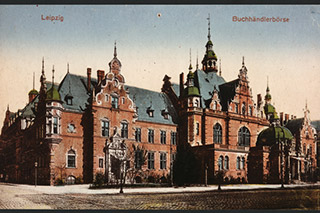 Image/Repro: DNB
Image/Repro: DNB
On 29 April 1888, the museum is reopened in the Deutsches Buchhändlerhaus at Hospitalstraße (what is today Prager Straße) in the heart of Leipzig’s Graphic Quarter. By installing galleries in the wing on Gerichtsweg, a room is created for the museum’s collections and for using and presenting its own objects. The museum is permitted to co-use the exhibition rooms of the Buchhändlerhaus. Owing to the self-interests of the Book Traders’ Association, limits are set on the expansion of the museum’s collections and its activities through use of the reading room, lectures and exhibitions.
1887
On 1 April 1887, Konrad Burger (1856–1912) is employed as “curator of the Book Industry Museum in Leipzig”. The steering committee and museum commission task him with closing gaps in the collections of old prints and searching for a suitable template collection for commercial and technical aspects, or establishing such a collection in-house.
1886
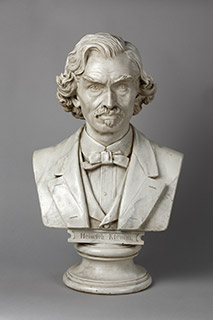 Photo: Klaus-D. Sonntag
Photo: Klaus-D. Sonntag
In May 1886, the provincial legislators of Saxony approve the purchase of the collection of incunabula and old prints (Bibliographic Museum) belonging to the Dresden-based publishers’ book trader, specialist author and editor Heinrich Klemm (1819–1886) using funds for the promotion of trades intended for the Leipzig Museum. The most precious object in the collection is a parchment copy of the Gutenberg bible with numerous miniatures and rich book decorations. A contract governing the use of this collection is signed on 2 June 1886. Klemm donates 50,000 marks as a fund for continuing the collections. A collection of templates from current book productions is begun using donations from those publishers participating in the regular exhibitions held by the Book Traders’ Association. In 1886, this collection already encompasses over 2,000 books and is continuously expanded, not least with donations from the annual exhibitions of the Book Traders’ Association.
1885
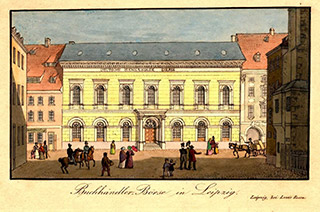 Image: DNB
Image: DNB
The museum’s first exhibition, held in the great hall of the Book Traders’ Exchange in Ritterstraße, is opened to the public on 12 July 1885. The exhibition presents manuscripts, old prints and early lithographs as loans from three private collections – from Heinrich Klemm’s “Bibliographic Museum”, the Apel Library in Ermlitz, and the company F. A. Brockhaus – as well as the museum’s own initial acquisitions. The room is cleared for the period of 14 days for each of the Cantate Sunday conferences held by the Book Traders’ Association; otherwise, the exhibition remains publicly accessible.
1884
A memorandum titled “The Future of the Book Trade in Leipzig” authored by Carl B. Lorck (1814–1905) and commissioned by the district of Saxony, the German Book Printers’ Association, the Association of Leipzig-Based Book Printers and the Typographical Association of Leipzig calls for the creation of a “first-class” museum. Presented internally to the Saxon authorities in April, the memorandum is published in edited form in July.
In May, the general assembly of the German Book Traders’ Association of Leipzig decides to host a museum for the book trade in its planned new Deutsches Buchhändlerhaus.
On 29 October 1884, around 80 Leipzig-based entrepreneurs working in the book industry and prominent figures of the cultural scene found the Central Association for the entire book trade, which seeks to implement the guidelines of the memorandum. Dr. Oskar von Hase (1846–1921), who had led the demands for reform on behalf of the Book Printers’ Association, becomes the Central Association’s chairman. A museum commission chaired by Gustav Wustmann (1844-1910), the head librarian of the Leipzig City Library, is put in place.
Last changes:
20.07.2022
Short-URL:
https://www.dnb.de/dbsmhistory

